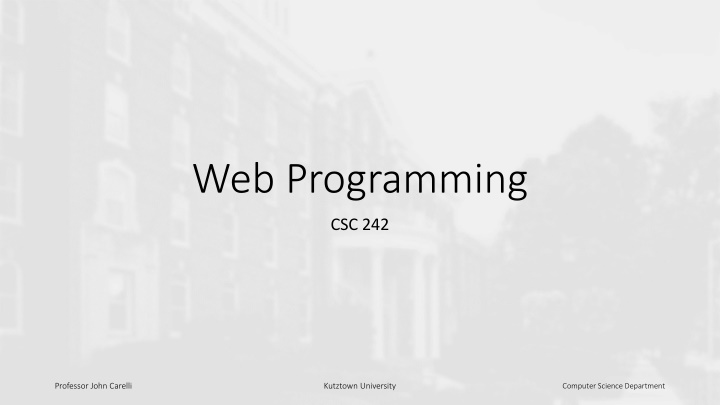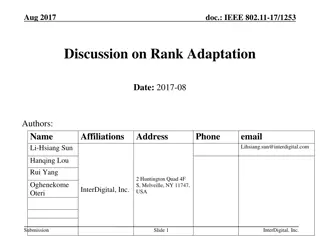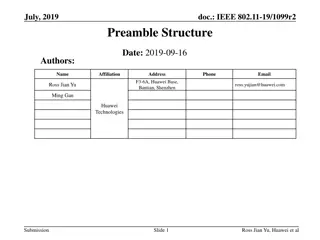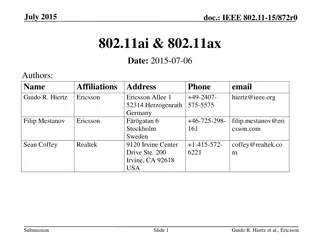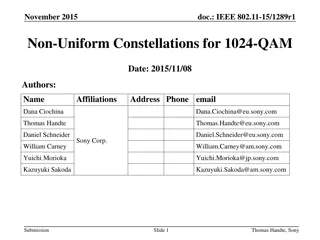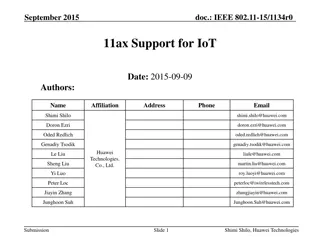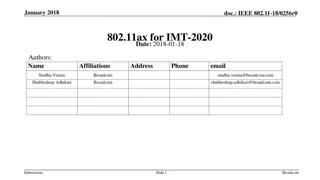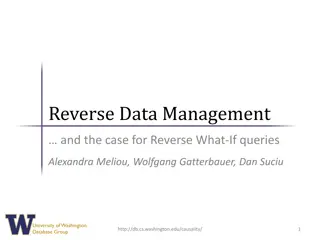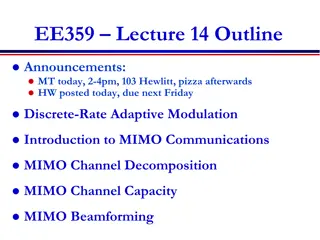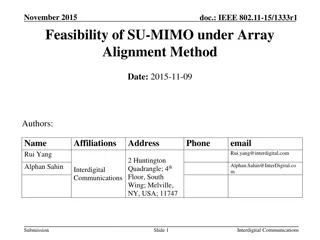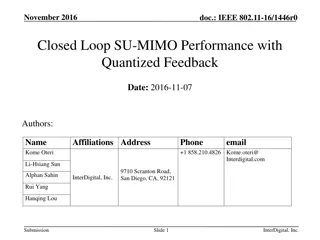Verifying 802.11ax UL MU-MIMO Throughput Gain Simulation Results
This document from November 2016 explores the verification of the promised four times throughput gain in IEEE 802.11ax using UL MU-MIMO. It includes simulation assumptions, results, and conclusions based on scenarios with varying STA numbers and BSS ranges, showcasing the achievable throughput gains. The study delves into the impact of different scheduling algorithms on throughput performance in indoor settings. The findings illustrate the potential for significant throughput improvement in 802.11ax networks under specific deployment conditions.
Download Presentation

Please find below an Image/Link to download the presentation.
The content on the website is provided AS IS for your information and personal use only. It may not be sold, licensed, or shared on other websites without obtaining consent from the author.If you encounter any issues during the download, it is possible that the publisher has removed the file from their server.
You are allowed to download the files provided on this website for personal or commercial use, subject to the condition that they are used lawfully. All files are the property of their respective owners.
The content on the website is provided AS IS for your information and personal use only. It may not be sold, licensed, or shared on other websites without obtaining consent from the author.
E N D
Presentation Transcript
Web Programming CSC 242 Professor John Carelli Kutztown University Computer Science Department
Introduction to PHP A scripting language used to allow for dynamic exchange of information between a client and a server runs on the server side (not on the client machine!) interpreted all major web servers contain interpreters loosely-typed language variables are not declared, they are created when used variable type is context dependent and can change Professor John Carelli Kutztown University Computer Science Department
PHP Basics PHP code is embedded in HTML contained within a php tag may be multi-line code is interpreted and executed when encountered statements end with a semicolon ; supports C++ style comments (both // and /* */) Variables must start with a $ (ex: $message) keywords, classes, functions and user-defined functions are NOT case sensitive variable names ARE case sensitive Example <?php $message = "Hello world"; echo "$message"; ?> Professor John Carelli Kutztown University Computer Science Department
PHP Variables All PHP variables begin with a dollar sign $ (from perl) variables do not need to be declared they come into existence when first used $x= 2; variable type is context dependent (it can change depending on usage) string literals can be created with either single or double quotes single vs. double quotes variables in double quotes are expanded $x=2; echo $x ; // will output 2 variables in single quotes are not expanded $x=2; echo $x ; // will output $x variables.php Professor John Carelli Kutztown University Computer Science Department
Variable Naming Rules Must start with a dollar sign ($) followed by a letter or the underscore character (_) Can only contain a-z,A-Z,0-9, and _ Variable names are case sensitive Source: Dylan Schwesinger Kutztown University Computer Science Department
Data Types PHP data types: String Number: (Integer and Float) Boolean Array Object NULL PHP is dynamically typed types of variables do not need to be declared PHP is generally weakly typed some type conversions are automatic Source: Dylan Schwesinger Kutztown University Computer Science Department
PHP Output Two basic commands for producing output: print and echo they are very similar to each other (see the box ) print or echo? either can be used with or without parenthesis print has a return value of 1 (can be tested in expressions) echo has no return value print allows only one argument echo can take more than one argument The output of both is interpreted by the browser as HTML Code FirstPage.php use a .php extension Professor John Carelli Kutztown University Computer Science Department
PHP Strings String literals can use either single or double quotes The difference: variables in double quotes are expanded (interpolated) $x=2; echo $x ; // will output 2 variables in single quotes are not expanded (literal) $x=2; echo $x ; // will output $x Backslash (\) is the escape character Concatenation with the dot (.) character John . . Doe -> John Doe variables.php Professor John Carelli Kutztown University Computer Science Department
Arithmetic Operators Source: Dylan Schwesinger Kutztown University Computer Science Department
Assignment Operators Professor John Carelli Kutztown University Computer Science Department
PHP Implicit Type Coercion The type of a variable is implicitly converted based on the context in which the variable is used In PHP this is called Type Juggling <?php $x = "10"; // string $y = 3.14; // float $z = $x * $y; // float ?> The gettype function returns a string representation of a variable s type Source: Dylan Schwesinger Kutztown University Computer Science Department
Explicit Type Casting (int), (integer) cast to integer (bool), (boolean) cast to boolean (float), (double), (real) cast to float (string) cast to string (array) cast to array (object) cast to object (unset) cast to NULL Source: Dylan Schwesinger Kutztown University Computer Science Department
PHP Constants Constants are similar to variables, but the value cannot be changed once set Syntax <?php define("NAME", "VALUE"); ?> NAME is the name of the constant and is traditionally upper case VALUE is the value assigned to the constant Source: Dylan Schwesinger Kutztown University Computer Science Department
Including and Requiring Files The include statement includes and evaluates the specified file The include_once statement includes and evaluates the specified file only once The require statement is identical to the include statement, but if a failure occurs, the script is halted The require_once statement is identical to the include_once statement but if a failure occurs, the script is halted Source: Dylan Schwesinger Kutztown University Computer Science Department
PHP, more basics Strings dot is the string concatenation operator John . . Doe -> John Doe substr(), strtok(), trim() . various string related functions Numerical functions round(), number_format() someBasics.php HTML tag functions htmlspecialcharacters(), strip_tags() Professor John Carelli Kutztown University Computer Science Department
phpinfo() Command for retrieving PHP-related information from the server since PHP is installed on the server, not the client Including version variable settings directives environmental settings phpINFO.php Professor John Carelli Kutztown University Computer Science Department
Looping and testing PHP offline testing and verification from C++ if elseif (one word) else switch for while do while break, continue exit (like C ), die (like perl) either can print a message php command: php a Interactive shell execute php commands php file.php Execute php code in file php l file.php lint option check syntax of php code in a file someBasics.php Professor John Carelli Kutztown University Computer Science Department
PHP Arrays Associative arrays index can be either a string or an integer a string containing a valid integer will be cast to an integer floats and bools get cast to integers (floats get truncated) index enclosed in square brackets $myArray[ one ] = 1; is_array() will return true if a variable is an array Printing individual elements must be enclosed in braces for printing print "Name= {$Student['name']}"; // error if no braces!!!! print_r() print an entire array: print_r($Student); enclose in <pre> tags to make it pretty: firstArray.php Professor John Carelli Kutztown University Computer Science Department
Sending Information to the Server Use an HTML form to collect user information set the method attribute in the form tag to either post or get set the action attribute to the name of the php page to execute upon submission Form information gets stored in either the $_POST or $_GET array, which accessible in the targeted php page Professor John Carelli Kutztown University Computer Science Department
post vs. get post transferred information is hidden from the user more secure get transferred information is visible in the URL sent to the server appended to URL after a ? keyword/value pairs separated by & can be sent directly via a link (no form) Examples: Sending Information to the Server Professor John Carelli Kutztown University Computer Science Department
More on Arrays Arrays examples and sorting arrayExamples.phpand sortArrays.php Arrays can be used in a form and passed as a single entity use of isset() and is_array() arrayInForm.php Professor John Carelli Kutztown University Computer Science Department
Functions use function keyword to declare a function use return keyword to return a value, is desired arguments and internally defined variables have local scope use global keyword to access variables defined outside of function arguments may have default values list() and array() functions.php Professor John Carelli Kutztown University Computer Science Department
Controlling settings and reporting ini_set() changes PHP settings error_reporting() changed PHP error reporting levels phpSettings.php check phpinfo() to see current settings feedback.html Professor John Carelli Kutztown University Computer Science Department
PHP file access Basic syntax: $f=fopen($filename, $mode); $line= fgets($f); // reads one line fwrite($f, $string); // write string feof($f) // detect end of file fclose($f); File access modes "r read only; starts at the beginning of the file "r+ read and write; starts at the beginning of the file "w write only; clears file contents or creates a new file "w+ read and write; clears file contents or creates a new file "a" write only; writes to end of file or creates a new file "a+" read and write; writes to end of file or creates a new file "x" write only; creates a new file - error if file exists "x+" read and write; creates a new file - error if file exists fileAccess.php File() function: $lines = file ("file.txt"); // read the entire file into an array With optional arguments: $trimmed= file ("file.txt , FILE_IGNORE_NEW_LINES | FILE_SKIP_EMPTY_LINES); Professor John Carelli Kutztown University Computer Science Department
PHP and OOP PHP supports Object Oriented Programming constructs Originally, it did not (started in php4, matured in php5) Now, both procedural and OOP approaches are supported Objects defined in a class Similar to C++ and Java Data members and methods can be public, private or protected A constructor (only one) may be defined PHP also supports references! $ref= &$var $this (in a class) is a reference to the instance itself objects.php Professor John Carelli Kutztown University Computer Science Department
Date and Time Set the time zone: date_default_timezone_set("America/New_York"); Format the date and time: $today = date ('Y-m-d H:i:s'); datetime.php Professor John Carelli Kutztown University Computer Science Department
